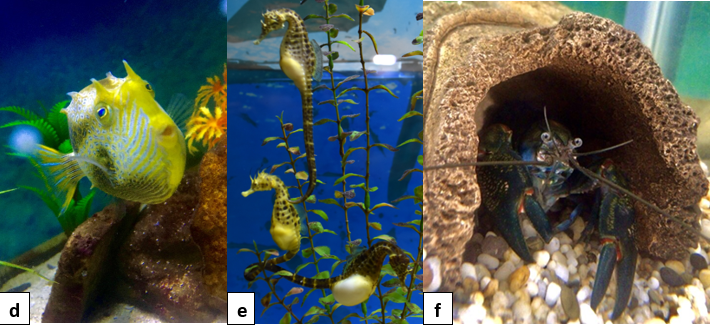
Article written by Florbela Morgado
The Marine Discovery Centre, located at Henley Beach SA, provides marine and coastal learning experiences and activities, by direct contact, encouraging children and adults to discover and appreciate the marine life and the importance of its conservation and protection.
The centre is divided in four areas, meticulously prepared to captivate the visitors’ attention and curiosity. Visitors in each area are guided by very passionate educators turning it into a unique experience of direct contact with marine and freshwater live animals, Aboriginal culture, biodiversity and ecosystems.
Beach exploring experience
Conveniently located close to the beach, visitors experience a guided walking tour through the Henley Beach sandy coast, giving children and adults, the opportunity to explore the diversity of fauna and flora, brought to the shore by the tides, such as shells, sea stars, seaweed, sea snails and many other interesting things, with informative scientific guidance.
 Figure 1: Images from the beach walking tours,a) Sea star commonly known as “feather star” found on the sand during low tide; b) Sea snails, Jujubinus polychroma sp., found in small pools during the low tide; c) Sand sculpture of a seahorse made by the children. (Photos: Florbela Morgado 2024)
Figure 1: Images from the beach walking tours,a) Sea star commonly known as “feather star” found on the sand during low tide; b) Sea snails, Jujubinus polychroma sp., found in small pools during the low tide; c) Sand sculpture of a seahorse made by the children. (Photos: Florbela Morgado 2024)
The Centre
When entering the Marine Discovery Centre, we immediately feel transported into an underwater environment as soon as we walk through the doors, with two large Salmon Catfish, (Neoarius leptaspis sp), welcoming and inspiring curiosity among children and adults, about the diversity of marine ecosystems and about other sea wonders they are about to experience in the Centre.
 Figure 2: Two Salmon Catfish, Neoarius leptaspis sp., welcoming visitors at the front door entry of the Marine Discovery Centre. (Photos: Florbela Morgado 2024)
Figure 2: Two Salmon Catfish, Neoarius leptaspis sp., welcoming visitors at the front door entry of the Marine Discovery Centre. (Photos: Florbela Morgado 2024)
Inside the Marine Discovery Centre, visitors experience interactive exhibitions designed for educating and inspiring conservation, to protect our river systems, to protect the marine environment, and awareness about water conservation.
Live Fish Tanks
The captivating beauty of live fish tanks displaying both, marine and freshwater environments, give visitors a close view of the underwater diverse ecosystems.
These carefully maintained water tanks offer visitors the opportunity to discover the wonders of live aquatic species such as Seahorses, different species of Pufferfish, Ornate Cowfish, Murray River Turtle, native Oysters, Sea Stars and many other local and non-local species. Some of the smallest babies of the sea, the delicate baby seahorses and sea star babies, that can be seen in the water tanks were born in the Marine Discovery Centre.
The virtual reality headsets provide to visitors the sensation of being transported to an underwater world, immersed by images, providing a deeper visual and multisensory connection to the real underwater environment. Visitors also have the opportunity to see an exceptional collection of seashells and whale bones, with information about their different species and sizes.
 Figure 3: In water tanks, d) Ornate Cowfish Aracana ornate sp.; e) Pot-Bellied Seahorse Hippocampus abdominalis sp.; f) Common Yabby Cherax destructor sp.; (Photos: Florbela Morgado 2024)
Figure 3: In water tanks, d) Ornate Cowfish Aracana ornate sp.; e) Pot-Bellied Seahorse Hippocampus abdominalis sp.; f) Common Yabby Cherax destructor sp.; (Photos: Florbela Morgado 2024)
Aboriginal Culture
A Captivating display of ancient aboriginal tools and instruments, with demonstrations of their appropriate techniques, used in traditional fishing, hunting and music playing allow visitors to experience the Kaurna cultural heritage of this region, and the importance of the “sea country” in the aboriginal culture.
 Figure 4: g) and h) Ancient aboriginal tools traditionally used for playing music, fishing and hunting. (Photos: Florbela Morgado 2024)
Figure 4: g) and h) Ancient aboriginal tools traditionally used for playing music, fishing and hunting. (Photos: Florbela Morgado 2024)
In Conclusion, through the exhibitions, presentations, demonstrations and interactive learning activities, the role of the Marine Discovery Centre is becoming increasingly important in educating, inspiring and protecting our marine and freshwater environment. The experience strongly encourages children to interact with the marine environment and its ecosystems.
References
Edgar GJ (2000) ‘Australia Marine Life: the plants and animals of temperate waters.’ (Reed New Holland: Sydney)